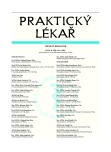Evolution and evolutionary theory for physicians. II.
Evolution – a scientific fact
Authors:
F. Koukolík
Authors‘ workplace:
Primář: MUDr. František Koukolík, DrSc.
; Národní referenční laboratoř prionových chorob
; Fakultní Thomayerova nemocnice s poliklinikou, Praha
; Oddělení patologie a molekulární medicíny
Published in:
Prakt. Lék. 2010; 90(2): 63-68
Category:
Editorial
Overview
Proof of evolution as a fact is most often based on paleontological observations, results of comparative anatomy, signs of embryonal development, description of vestigial structures, geographical distribution species and results of molecular methods. The paper supports evolution as a fact by three evolutionary streams:
– water-land using a tetrapod example,
– land-water using whales as an example,
– land-air using „feathered dinosaurs“ as examples,
and by comparative anatomy of cortical fields of the mammalian brain, by geographical distribution species, and by evolution of genome and proteosynthesis.
Key words:
evolution, fact, paleotontological observations, cortical fields, biogeography, genome evolution, proteosynthesis evolution.
Sources
1. Ahlberg, P.E., Clack, J.A. A firm step form water to land. Nature 2006, 440, p.747-749.
2. Animace – desková tektonika [on-line]. Dostupné na http://www.ucmp.berkeley.edu/geology/anim 1.html.
3. Beck, R.M.D., Godthelp, H., Weisbecker, V. et al. Australia’s oldest marsupial fossils and their biogeographical implications. PLoS ONE 2008, 3(3), e1858. doi:10.1371/journal.pone.0001858.
4. Bertini, I., Cavallaro, G., Rosato, A. Evolution of mitochondrial-type cytochrome C domains and of the protein machinery for their assembly. J. Inorg. Biochem. 2007, 101, p. 1798-1811.
5. Bokov, K., Steinberg, S.V. A hierarchical model for evolution of 23S ribosomal RNA. Nature 2009, 457, p. 977-980.
6. Budd, G.E. The earliest fossil record of the animals and its significance. Phil. Trans. R. Soc. B. 2008, 363, p. 1425-1434.
7. Crick, F.H. The origin of genetic code. J. Mol. Biol. 1968, 38, p. 367-379.
8. Daeschler, E.B., Shubin, N.H., Jenkins, F.A. Jr. A devonian tetrapod-like fish and the evolution of the tetrapod body plan. Nature 2006, 440, p. 757-763.
9. Dawkins, R. The ancestor’s tale. A pilgrimage to the down of life. Phoenix, London 2005.
10. Doudna, J.A., Rath, V.L. Structure and function of the eucaryotic ribosome: the next frontier. Cell 2002, 109, p. 153-156.
11. Futuyma, D.J. Evolutionary biology. 3rd. ed. Sunderland: Sinauer Associates, 1998.
12. Geisler, J,H., Theodor, J.M. Hippopotamus and whale phylogeny. Nature 2009, 458: E1-E4. doi:10.1038/nature07776.
13. Gilbert, W. Origin of life: The RNA world. Nature 1986, 319, p. 618.
14. Gould, S.J. The structure of evolutionary theory. Cambridge, Mass: Belknap Press of Harvard University Press, 2002.
15. Gore, P.J.W. Historical geology online laboratory manual. Georgia Perimeter College Bookstore, 2010, p. 247-268
16 Gradstein, F.M., Ogg, J.G. The geologic time scale. In Hedges SB, Kumar S. (eds.). The Timetree of Life. Oxford University Press, 2009.
17. Chen, P., Dong, Z., Zhen, S. An exceptionally well-preserved theropod dinosaur from the Yixian Formation of China. Nature 1998, 391, p. 147-152.
18. International Commission on Stratigraphy. www.stratigraphy.org
19. Koonin EV, Novozhilov AS. Origin and evolution of the genetic code: the universal enigma. IUBMB Life 2008, 61, p. 99-111.
20 Krubitzer, L. In search of unifying theory of complex brain evolution. Ann. NY Acad. Sci. 2009, 1156, p. 44-67.
21. Krubitzer, L., Hunt, D.L. Capture in the net of space and time: understanding cortical field evolution. In: Kaas JH, Krubitzer L. (eds.) The evolution of nervous systems. Volume 3: Mammals. San Diego: Elsevier, p. 49-52.
22. List of transitional fossils [on-line]. Dostupné na http://en.wikipedia.org/wiki/List_of_transitional_fossils
23. Losos, J.B., Ricklefs, R.E. Adaptation and diversification on islands. Nature 2009, 457, p. 830-836.
24. Mayr, E. What evolution is. New York: Basic Books, 2001.
25. Ogle, J.M., Brodersen, D.E., Clemons, W.M. et al. Recognition of cognate transfer RNA by the 30S ribosomal subunit. Science 2001, 292, p. 897-902.
26 Prothero, D.R., Schoch, R.M. Horns, tusks, and flippers. The evolution of hoofed animals. Baltimore: Johns Hopkins University Press, 2002.
27. Ridley, M. Evolution. 2nd ed. Cambridge, Mass.: Blackwell Science 1996.
28. Shubin, N.H., Daeschler, E.B., Jenkins, F.A. Jr. The pectoral fin of Tiktaalik roseae and the origin of tetrapod limb. Nature 2006, 440, p. 764-771.
29. Stilman, B. (ed.) The ribosome. Cold Spring Harbor Symposia on Quantitative Biology. Cold Spring Harbor Laboratory Press, 2001.
30. Thewissen, J.G.M., Williams, E.M., Roe, L.J et al. Skeleton of terrestrial cetaceans and the relationship of whales to artiodactyls. Nature 2001, 413, p. 277-281.
31. Thewissen, J.G.M., Cooper, L.N., Clementz, M.T. et al. Whales originated from aquatic artiodactyls in the Eocene epoch of India. Nature 2007, 450, p. 1190-1194.
32. Thewissen, J.G.M., Cooper, L.N., Clementz, M.T. et al. Replying to: J. H. Geisler & J. M. Theodor. Nature 2009, 458, E5. doi:10.1038/nature 07775.
33. Tiktaalik, 2010. [on-line] Dostupné na http://tiktaalik.uchicago.edu
34. Unwin, D.M. Feathers, filaments and theropod dinosaurs. Nature 1998, 391, p. 119-120.
35. Warnecke, T., Weber, C.C., Hurst, L.D. Why there is more to protein evolution than protein function: splicing, nucleosomes and dual-coding sequence. Biochem. Soc. Trans. 2009, 37, p. 756-761.
36. Woese, C.R., Fox, G.E. The concept of celullar evolution. J. Mol. Evol. 1977, 10, p. 1-6.
37. Woese, C., Kandler, O., Wheelis, M. Towards a natural system of organisms: proposal for the domains Archaea, Bacteria, and Eucarya. Proc. Natl. Acad. Sci. USA 1990, 87, p. 4576-4579.
38. Zhang, F., Zhou, Z., Wang, X. et al. A bizarre Jurassic maniraptoran for China with elongate ribbon-like feathers. Nature 2008, 455, p. 1105-1108.
39. Zrzavý, J., Storch, D., Mihulka, S. Jak se dělá evoluce. Od sobeckého genu k rozmanitosti života. Praha: Paseka, 2004.
Labels
General practitioner for children and adolescents General practitioner for adultsArticle was published in
General Practitioner

2010 Issue 2
Most read in this issue
- Tracheal stenosis, diagnosis and treatment options
- Radicular syndrome in the general practitioner’s surgery
- Differential diagnosis of oedema
- Substance abuse preventinon and approaches to managing of cure dependence
